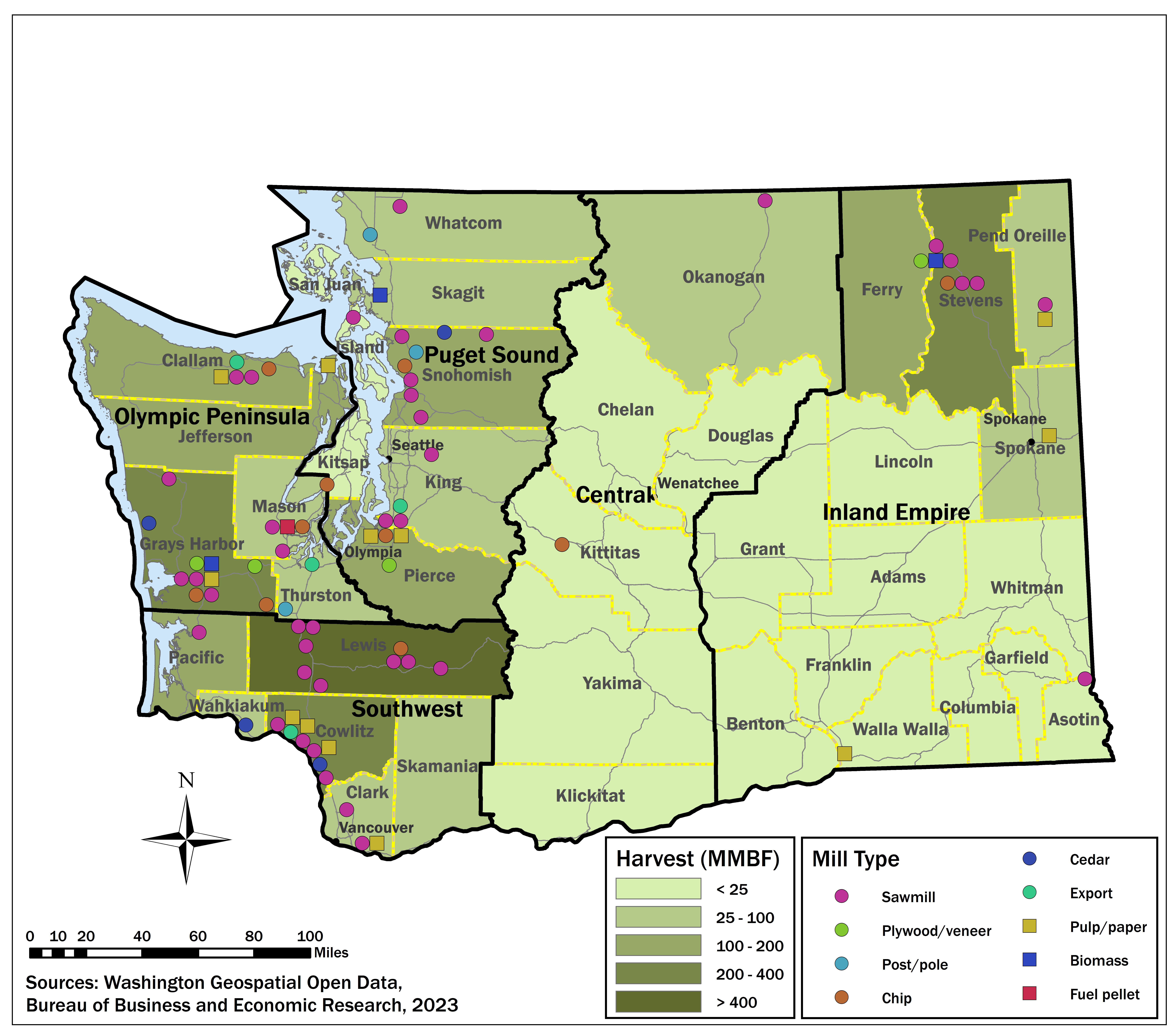WASHINGTON

The BBER’s Forest Industry Research Program works throughout the Western United States doing a variety of research and data collection projects. This page will pull together information and data the program has compiled for the state of Washington.
Active Washington timber processing facilities, 2020

Forest Products Industry and Timber Harvest Reports
Timber Harvest
In cooperation with the Forest Service’s Pacific Northwest Research Station, the BBER has developed a new interactive tool allowing users to access timber harvest data at the county- and ownership-level. (click here)
This project was made possible, in part, by funding from the Northwest Advanced Renewables Alliance (NARA) supported by the Agriculture and Food Research Initiative Competitive Grant no. 2011-68005-30416 from the USDA National Institute of Food and Agriculture.
Timber Processing Capacity
Pacific Coast Temperate Forest Regional Timber Product Flow Analysis
Pacific Coast Temperate Forest Regional Timber Product Flow Analysis (September 2023)
Impact of the Great Recession and Housing Collapse on the Forest Products Industry in the Western United States
Forest Products Journal (Vol. 61 No. 8, 2012)
Timber-Processing Capacity and Capabilities in the Western United States
Presentation slide show (pdf)(2004)
See also: Forest Products Journal 55(12):143-147 (July/August, 2006)
Logging Utilization
The BBER's logging utilization studies provide information on the diameter distribution of harvested trees, descriptions of harvesting techniques and equipment used by loggers, and removals factors describing the proportion of material utilized and left in the woods from growing-stock and sawtimber sources.
Logging Utilization in Oregon and Washington, 2011- 2015
Recent Posters
2017 Estimating felled-tree stump volumes in the Pacific Northwest
The Great Recession and the Western Forest Products Industry Poster (2012)
Timber-Processing Capacity in the Western United States (2006)
Biomass Studies
A comparison of methodologies for estimating delivered forest residue volume and cost to a wood-based biorefinery in Biomass and Bioenergy 106 (2017) by Natalie Martinkus, Greg Latta, Todd Morgan and Michael Wolcott
A study to enhance the ability of federal land managers in the Western United States to address the financial and economic aspects of woody biomass removal was funded by the Joint Fire Science Program. The study was broken into two parts.
A compilation of an annotated bibliography on the body of economic and financial information and tools currently available to federal land managers.
Conducting focus groups with federal land managers throughout the West to understand their current knowledge and use of existing information and tools as well as barriers to biomass utilization,
Enhancing Western Managers' Knowledge and Use of Available Economic and Financial Biomass Information and Tools
Results from this study were presented as a poster at the Society of American Foresters Annual Meeting in Orlando, Florida in October 2009. Additional biomass research from the Joint Fire Science Program can be found here.
Northwest Advanced Renewables Alliance (NARA)
The Northwest Advanced Renewables Alliance has brought together scientists from public universities, government laboratories and private industry from throughout the Northwest, and beyond, to focus on developing ways to turn one of the region's most plentiful commodities—wood and wood waste—into jet fuel.
This project was made possible, in part, by funding from the Northwest Advanced Renewables Alliance (NARA) supported by the Agriculture and Food Research Initiative Competitive Grant no. 2011-68005-30416 from the USDA National Institute of Food and Agriculture.
Workforce and Employment
Forestry workers and businesses are a critical component of the forest industry, providing the labor and expertise to produce goods and manage our natural resources. Understanding the capacity to meet current and future demands and the barriers and challenges forestry businesses face are essential to maintaining a strong industry across all segments of the supply chain. The BBER also tracks the economic contribution of the industry at the state and regional level.
Washington Partners
USDA Forest Service Pacific Northwest Research Station – Forest Inventory and Analysis (FIA) Program

